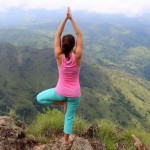Finding a Sense of Calm at the Vipassana Meditation Center

I had never meditated before, and had only taken a couple of yoga classes. Then I met Henrik in Western Australia, who told me that he had spent three weeks in a Buddhist temple in Thailand. When I saw him again in Tasmania during a seven-day trek, I became more interested in his experience. I told him that it was always hard for me to concentrate, and that I always have thousands of thoughts in my head. He gave me some basic guidelines to relax and meditate and told me that if I ever visited Thailand, I needed to visit the Buddhist temple.
Since then, I began meditating. I tried to make myself relax and get rid of all of my thoughts, and I was even able to make small pains and itches disappear. I traveled to Thailand, and with one week left in the country, I headed south to spend a week at the Vipassana Meditation Center for the Development of the Mind.
The center is led by a monk, the Phra Arjan. But because I am a woman, I was mostly in contact with a nun named, Akun Ta. An extraordinary woman, she would have been a monk if she were a man. She didn’t speak English so Na, a practisioner, translated for me.
In our daily life, we do things mechanically, like wash the dishes while putting together a shopping list, go for a run while making calculations, and eat while watching TV. We do not pay attention to anything we do and so, we do not do anything completely.
On my fourth day at the center, I told them that it was amazing to be able to experience so many different things when we actually use our minds. Akun Ta corrected me and said that we do use our minds for everything. Our problem is that we do not observe. In our daily life, we do things mechanically, like wash the dishes while putting together a shopping list, go for a run while making calculations, and eat while watching TV. We do not pay attention to anything we do and so, we do not do anything completely.
It’s hard to explain what I experienced during that week. You have to experience it for yourself. But I can explain the methodology. I learned three types of meditation: sitting meditation, walking meditation, and activity meditation. Every day, I was told to practice as part of my homework, and in the evenings, we had a conversation to see how was I doing.
In each exercise, they asked me what I felt, and what I saw. If the answers weren’t the ones they expected, they asked me to try again and observe once more. They never said that I was doing things wrong because each person is different and has different reactions to the same action. But once I started feeling the things that they expected of me, they said, “Yes, that’s right, you’re on the right way.”
Sign up for a FREE online writing workshop here.
Everyone living at the center was Buddhist. When they asked me if I was Christian, I told them that by tradition, most Spaniards are Catholic, but don’t practice–especially the younger generations. My parents allowed me to choose what I wanted to be when I grew up. I do not consider myself a religious person, and I don’t particularly like religion.
At the Meditation Center, no one–not even once–mentioned the word Buddhism. No one tried to convince me that their religion was the real one. They didn’t ask for any money. In fact, no one tried to convince me of anything. They just said, “It is difficult to explain meditation. You will have to try it, and if you find it beneficial, just keep doing it and practice it in your daily life.”
In today’s world, horrible things are happening in the name of religion. Finding a place like this where people truly care makes life easier.
Photo for Finding a Sense of Calm at the Vipassana Meditation Center by Unsplash.








